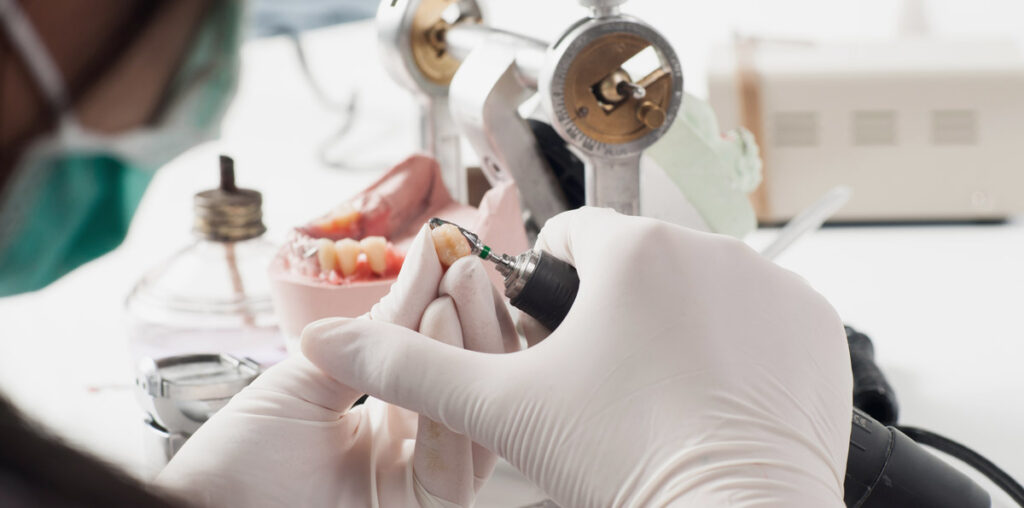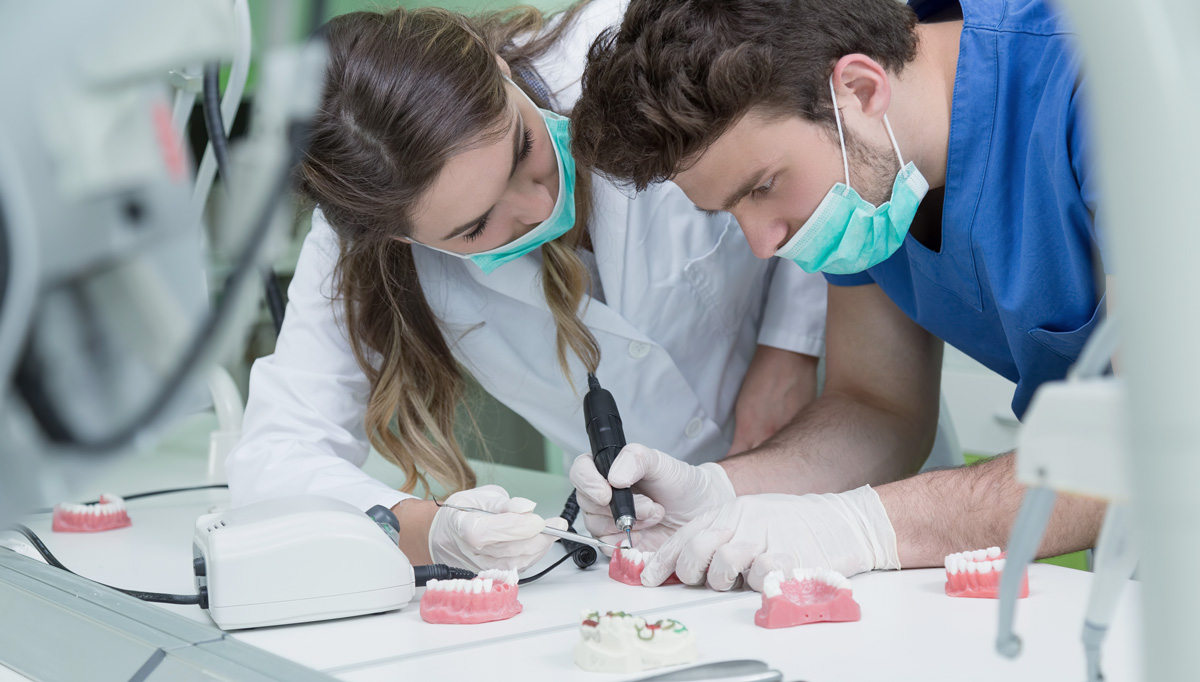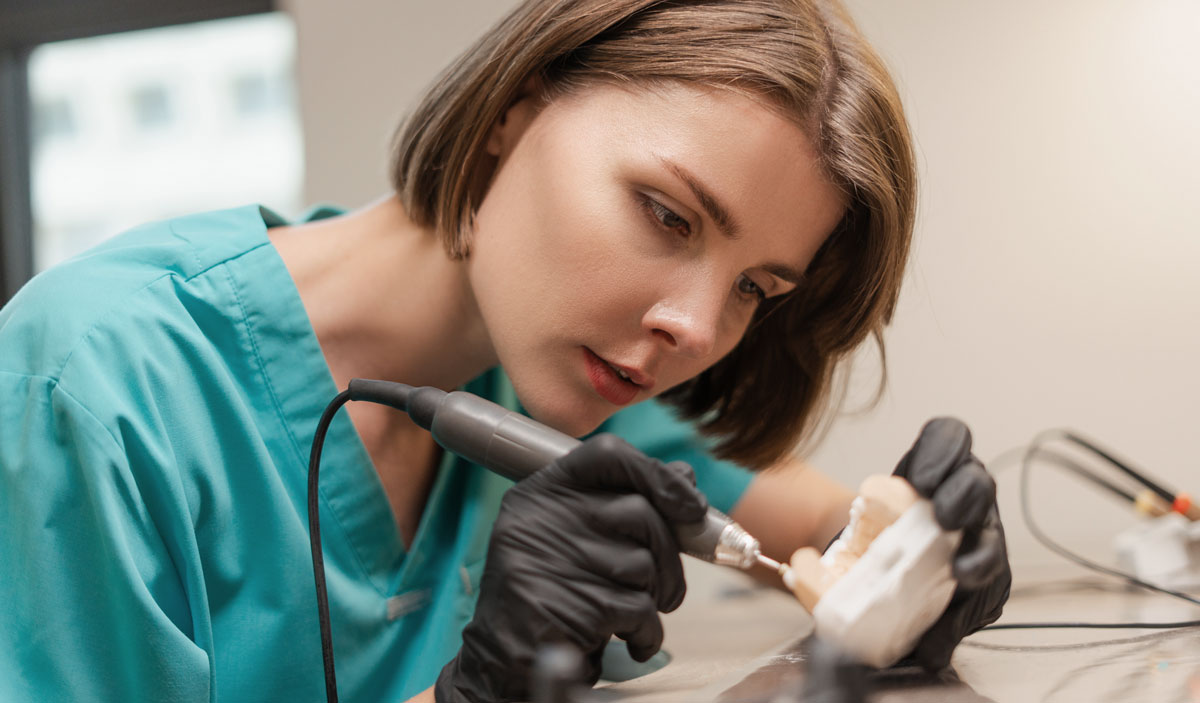A dental lab technician plays an essential role in delivering effective dental care. Working behind the scenes, these skilled professionals use advanced dental technology and craftsmanship to construct dental appliances that improve patients’ appearance and restore oral function.
From crowns and bridges to other dental appliances, dental technicians work closely with dentists to create customised restorations that look and feel like natural teeth.
Let’s now explore the role of dental lab technicians, how they collaborate with the wider dental team, and how you can become one through various dental technology programmes.
What does a dental lab technician do?
Daily tasks and responsibilities
A dental lab technician is responsible for creating, repairing, and modifying a wide range of dental appliances, including crowns, bridges, dentures, mouth guards, and special trays. These are designed to replicate or support natural teeth. Using precise measurements from a dental practice, dental technologists construct dental appliances tailored to each patient’s individual needs.
Technicians use a blend of traditional handcrafting skills and cutting-edge digital dental tools to fine-tune restorations, ensuring comfort and functionality. Materials vary depending on the type of appliance but often include ceramics, metal alloys, and acrylic resins.
Working closely with dentists and clinicians
Although dental technicians may not have direct contact with patients, their collaboration with dentists is critical. Dentists provide impressions, scans, and specifications from clinical assessments, and technicians interpret this data to create accurate restorations. Clinical dental technicians, who are qualified to work directly with patients, sometimes bridge the gap between the laboratory and clinical care.
Most dental technicians are based in a dental laboratory, but their work has a direct impact on a patient’s general dental welfare.
The restoration process: from prescription to perfection
Understanding patient-specific requirements
Every patient’s dental care needs are different. Technicians must understand a wide range of clinical conditions, aesthetic goals, and functional requirements to produce effective restorations. Whether replacing a single tooth or fabricating full mouth restorations, their work is fundamental to both the health and confidence of patients.
Turning impressions and scans into restorations
The process often begins with impressions or digital scans taken in the dental practice. Dental technicians then use computer-aided design (CAD) systems to model restorations on screen before crafting them using various materials. This approach is part of the broader field of reconstructive sciences and reflects the ongoing digital transformation of dental technology.

Crafting aesthetics: materials and techniques
Selecting appropriate materials for each restoration
Choosing the right material is important to make sure a dental device works well, fits properly, and looks natural. Dental technicians choose materials based on what the dentist needs, what suits the patient, and the type of treatment. Common materials include zirconia, porcelain, metal, and acrylic. These can be used on their own or mixed together to create realistic-looking teeth.
Achieving lifelike results through expert craftsmanship
The ability to mimic the shape, shade, and translucency of natural teeth is a key skill for any dental technician. From layering porcelain for a natural finish to hand-polishing restorations for comfort, this fine craftsmanship requires intense focus and attention to detail. Dental technologists also continue to train and improve their skills to keep up with new techniques and technologies.
Technology in the modern dental laboratory
The rise of digital dentistry and CAD/CAM systems
Modern dental laboratories are increasingly embracing digital dental systems such as CAD/CAM, which allow for faster, more accurate design and fabrication of crowns, bridges, implants and other appliances. These tools enhance precision and efficiency and are often used alongside traditional methods.
Embracing innovation: 3D printing and beyond
New developments in dental technology include 3D printing, which is used to produce custom trays, temporary crowns, and complex frameworks. This innovation allows dental laboratories to offer a wider range of products with reduced turnaround times, helping to meet the growing demands of dental practices across the UK.
How to become a dental technician
Training pathways and qualifications in the UK
To become a dental technician, you typically need to complete a dental technology foundation degree, a diploma in dental technology, or an equivalent qualification. Some enter the field through apprenticeship training schemes, which combine full-time work with study. A-levels in science subjects or related qualifications may be required, depending on the programme.
Dental technology programmes are offered at several colleges and universities across the UK. Entry requirements vary depending on the course, but they usually include GCSEs and/or A levels, particularly in science or design subjects. Trainee dental technicians often begin working on a full time basis while studying part-time.
Career progression and opportunities in the field
Once qualified, dental technicians must register with the General Dental Council (GDC) to practise legally in the UK. With experience, technicians may specialise in specific areas such as crowns and bridges, implants, or orthodontic appliances. Others may train to become a clinical dental technician, allowing for direct patient contact.
Dental technicians can work in NHS or private dental laboratories, within dental practices, or even in teaching and research roles within dental technology. The career also offers job security, structured progression, and paid holidays, often including bank holidays, making it an attractive option for many.
GoDigital Dental: an expert team of dental technicians on your side
At GoDigital Dental, we combine expert craftsmanship with advanced digital dental technology to create high-quality restorations tailored to each patient. Our skilled team of GDC-registered dental lab technicians works closely with practices across the UK to produce crowns, bridges, and other dental appliances that enhance both function and appearance.
Based in the UK, our dental laboratory is supported by a dedicated client care team focused on clear communication and fast, reliable service. When you choose GoDigital Dental, you’re choosing a trusted partner committed to helping your practice deliver the very best in patient care.



